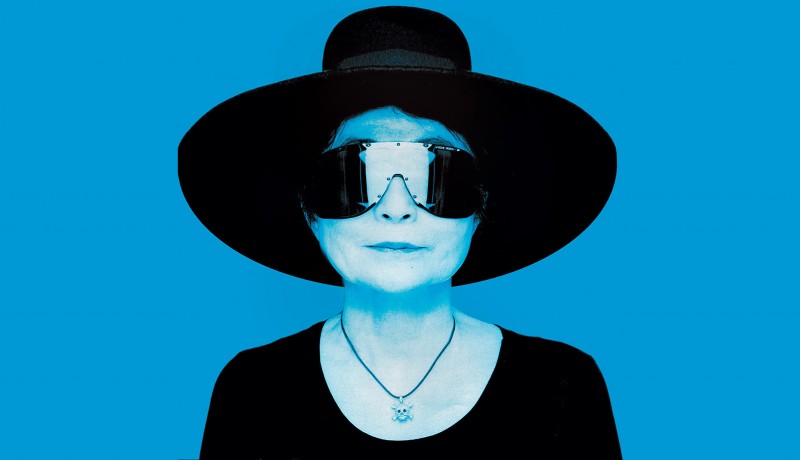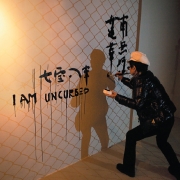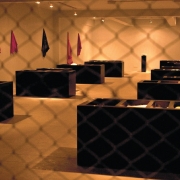
People

At 79, Yoko Ono is marching strong, making art, campaigning for world peace and spiritual calmness, and keeping alive John Lennon’s memory on her visit to India, discovers Sudha G Tilak
Envy hits you upon setting eyes on Yoko Ono for the first time. She belies her age. This is not a cute granny knitting woollies for a doting grandchild, but a seasoned public personality who carries an enduring memory of a genius (Beatles front-man John Lennon), talking hard of things that make an impact—world peace, gender, empowerment, spiritual connect with the world around us—and now, in India for more than a month, showcasing her conceptual and public art projects that will focus on the cause of women’s empowerment.
Petite, hair mussed artfully and worn short around her face with a trilby hat and dark glasses, in trademark dominatrix black leather, Yoko Ono seems in control. At a press conference, her face remains a mask, creasing child-like in little smiles while she delivers her lines with practised ease and little pauses. She is here in Delhi showcasing her conceptual art for over two months dedicated to gender empowerment at Vadehra Gallery. Titled Our Beautiful Daughters, it is a mammoth show and will showcase nothing less than 20 public art projects at various venues at schools, hospitals, the American and Japanese consulates, and a parallel exhibition The Seeds, a special installation piece on gender for her Indian visit at Vadehra Art Gallery. She will also collaborate with local craftswomen to produce work to commemorate her Indian sojourn.
“Her works elicit audience response and participation,” says Vidya Shivadas, curator for Ono’s exhibitions in Delhi. “She has often spoken about the distortion and indoctrination that takes place in society today and the need to foreground individual experience and agency, so people can clarify how they relate to the world and each other. We look forward to the exchange between Yoko Ono’s art and the audiences here, and how the two will be transformed in the course of the exhibition.”
Yoko Ono (her name means ocean’s child in Japanese) was described by her late husband John Lennon as a “famous unknown artist: everybody knows her name, but nobody knows what she does”. Well, we know now. As Roshini Vadehra, director of Vadehra Gallery who is hosting Yoko Ono’s many art projects for the first time in India, says, “She is a committed artist whose works have been talking points for decades now.” When she first began to showcase her work in the 1960s, she was described as ‘avant-garde’.
You come close to believing it as Ono’s unit works in a fashion that befits a rock star. Her photographs are quickly checked before passing through to the publicity, her associates monitor our chat, clarifying and offering details; all the time her photographer comes around taking photographs.
Ono’s public face as an artist began in the early 1960s when she moved from Japan to Manhattan, then the hub of artists in America. She hung around Fluxus, a group of avant-garde artists who were inspired by Dada, a cultural movement incorporating poetry, lyrics and graphic design that challenged conventional art and social mores and chose irrationality and surrealism as vehicles of expression. Fluxus founder George Maciunas is said to have promoted her, finding promise in Ono’s work. Yet, she preferred not to join and chose to work as an independent artist. She once used a fly as a symbol of her alter ego for an exhibition; in another aspect of conceptual art, Cut Piece, exhibited in Tokyo, New York and London, she stood wrapped in a loose garment and visitors to the exhibit had to scissor away the material around her until she stood shorn and naked; and in Painting to be Stepped On, where material or fabric was spread on the floor of the exhibition, the artwork evolved as visitors left their footprints on it.
Through her own peace prize (inaugurated in 2002) and many memorials and performance art works, Yoko Ono continues to champion and support peace, the marginalised, the gay community. Does she find the peace her sisters sought during the Imagine days in the 1960s valid today? “The peace we sought then is nothing like the need we have now to seek the same. We are now at a point in time that we will all sink together unless we work together for Peace,” she warns.
Age has not withered Ono’s rage against gender inequity. Gender, sexism, identity, suffering and imagination, being and consciousness become themes she continues to explore through her performances; existential art and communal participation mark many of her art works even today. She was also a part of the New Wave music trend (a subgenre of rock music) and made short films. In 1966, her short film titled No.4 or Bottoms exhibited in America showed extreme close-ups of posteriors as the subjects were walking on a treadmill; in 2004 in London, her piece My Mummy was Beautiful showed enlarged photo images of a woman’s breast and vulva, presumably Lennon’s mother, Julia Lennon. Many were shocked while Yoko Ono wondered why the nurturing and life-giving aspects were rejected. Following the nature of her work and performances, she was more often tagged controversial following the unconventional appeal of her art that was often misunderstood and labelled shocking than serious. “We give birth to the human race, yet are seen as objects,” she says.
In 1996, she produced Wish Tree, which involved a live tree and visitors sticking their wishes on it that is a part of her India exhibits as well. This year the ficus tree will be placed at different venues in the capital beginning January until March. “I’ve pasted my wish for India already,” Yoko Ono says cheerfully invit-ing the people of the city to paste their wishes on paper tags. These will be taken to enjoin the many wishes on the tower of light and peace at Reykjavik in Iceland at the Lennon Ono Imagine Peace Tower. And she has made her one big wish for India’s daughters too: “Be yourself and have respect and love for what you are.” For those sceptics who quiz how art can help counter violence and inequalities, Yoko Ono only has this to say: “Art is another strong power which could change the world. Let it be, without having too much doubt of what it can do.”
At Delhi’s Vadehra Art Gallery, Yoko Ono is able to touch on the gender quotient immediately. Her installation has various fabrics on the wall coloured in the tie-and-dye process by Rajasthani women, a tribute to the work of unsung Indian craftswomen. “We are seemingly not equal, but we are. The beautiful work done by Indian women is helping the world as part of the Peace Industry, quietly and strongly,” she says. On the floor space stand dark coffin-like boxes that hold silicone forms of female bodies on beds of coal. She picks a brush and black paint and writes on the wall, ‘I am uncursed’, clearly an indication of the ac-cursed status of women in India.
“An Irish activist said, ‘It’s better to stand up and be shot than to live on your knees’,” Ono tells Harmony-Celebrate Age. “I say, ‘One day, we will stand up and see that they won’t shoot us, because they will need more women’. The world needs women power, and men are starting to notice that very rapidly.”
Indeed, protest remains pivotal to performance for Yoko Ono whose art is a call for action. This is strictly not her first visit to India; that was probably in the Sixties but she cannot “remember the date now”. She and Lennon had a famous stay-in at a hotel in Mumbai for a couple of days and then travelled to a neighbouring ashram. However, the artist-couple had protested at the segregation of men and women devotees at the guru’s feet and she muses with a smile now, “Maybe it was rude, but John held on to me and insisted we sit together for the evening discourse.”
As a feminist of an earlier generation, Yoko Ono’s opinion on gender issues in India is linked to her observations from across the world. “The struggle for World Peace is parallel to the struggle of women,” she observes. “Men are starting to realise that it is getting harder and harder to control women and make them be what men want them to be. Smart men are starting to notice that it is simpler to join women and bring a peaceful world together. Right now, men are writing a script for doomsday for all of us by trying to control the world with might, while killing the strong nurturing power of women.”
Among her many battles against inequities, pushing 79, Yoko Ono has defied the ageism tag levied so harshly against women. She walks at a brisk pace, her eyes are rimmed by dewy lashes and her shoulders are straight; her black pants and jacket add a hint of mystery. She admits to feeling “freer and more energetic” spiritually and physically at her age now. Ageism may be a nagging worry across a world that loves youth but Ono looks fighting fit. She dismisses age and its additional discrimination on women in society and disregards her own advancing years: “Time is a man-made concept. I don’t go by it.”
WOMAN
This song, written and performed
by John Lennon from his 1980 album
Double Fantasy, is an ode to his “wife
Yoko Ono and to all women”
Woman, I can hardly express
My mixed emotions and my thoughtlessness
After all, I’m forever in your debt
And woman, I will try to express my inner feelings and thankfulness
For showing me the meaning of success
Woman, I know you understand the little child inside a man
Please remember, my life is in your hands, and woman
Hold me close to your heart, however distant don’t keep us apart
After all it is written in the stars
Woman, please let me explain
I never meant to cause you sorrow or pain
So let me tell you again and again and again
I love you, now and forever
I love you, now and forever
Featured in Harmony — Celebrate Age Magazine March 2012
you may also like to read
-
For the love of Sanskrit
During her 60s, if you had told Sushila A that she would be securing a doctorate in Sanskrit in the….
-
Style sensation
Meet Instagram star Moon Lin Cocking a snook at ageism, this nonagenarian Taiwanese woman is slaying street fashion like….
-
Beauty and her beast
Meet Instagram star Linda Rodin Most beauty and style influencers on Instagram hope to launch their beauty line someday…..
-
Cooking up a storm!
Meet Instagram star Shanthi Ramachandran In today’s web-fuelled world, you can now get recipes for your favourite dishes at….









